Last updated: 22 October 2002
|
Last updated: 22 October 2002 |
This page documents Canon 35mm film camera models comments, tips, and photos. Search the site for "Canon" for other items about the Canon cameras. Contributions welcome.
Jump to the Start of Today's Update (please wait for the page to finish loading).
Subject: Astro pics Sent: Monday, January 14, 2002 4:14:07 From: saber@dircon.co.uk (saber) I haven't really had the opportunity over the past few months to get much observing done, however a couple of weeks ago we had a very cold snap here in London and the seeing was the best it could probably get in inner London. I tried my hand at astrophotography for the first time and I've attached a couple of my more acceptable shots. I've darkened the pictures a little with Photoshop to bring out the stars more, because of the light pollution here. I used an EOS 300 with a 300mm zoom lens on a manfroto tripod. Also when attaching my SLR to the back of the 125 does the 125 effectively act as a 1900mm zoom lens? Finally since I do not want the expenditure of ccd as yet, I am thinking of buying a digital camera which I understand is just suspended on a mount over the eyepiece. Does this negate the need for long exposure since you are taking a picture of the image seen in the lens or are the pictures taken as you would with a normal camera, if the latter is correct presumably I need a camera with manual shutter/exposure facility or would a full auto camera be ok. Any suggentions on a camera up to say 250 Sterling? Happy New Year!! Regards, Sam
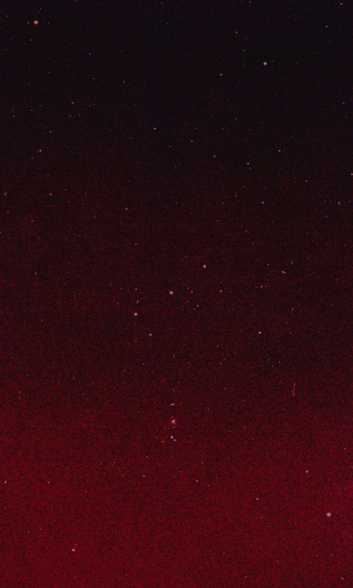
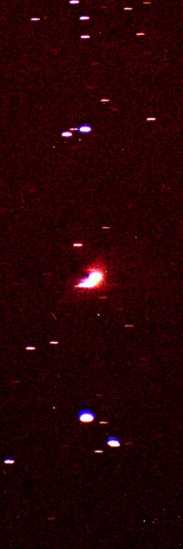
From: sherrodc@ipa.net (Clay Sherrod) To: saber@dircon.co.uk (saber), etx@me.com If you attach the camera prime focus to the SLR, yes you are converting it to a 1900mm TELEPHOTO lens of f/15 focal stop. For deep sky photography at prime focus, you are pretty much limited with a digital camera although they are great for planetary and lunar....the exposures are limited to around 16 sec. to 60 sec. on most. For the money the Olympus C-3000 is by far my favorite. You must operate the camera fully manual, including focus and all exposure settings for best results. If you are really interested in short exposure deep sky work, you probably should be looking more toward a CCD camera which you can pick up very reasonably on the used market. Good luck and thanks for the photographs! ClayMike here: One comment: most digital camera do not have a removable lens and so can not be used at prime focus. Such cameras work well for afocal photography using an eyepiece (see the Astrophotography page and the Astrophotography Galleries for tips and examples).
Subject: ETX-60AT Moon Picture Sent: Saturday, February 2, 2002 12:52:48 From: mswillett@erols.com (Michael Willett) Really enjoy your website. Like seeing the results other folks get with my telescope (and it makes me want to get a bigger one!) This is one of my first attempts with an ETX-60AT. Used 2x barlow lens element screwed into end of Meade basic camera adapter, Canon Elan IIE camera, ISO 100 film at 1/60 second. Scanned the picture on Canon flatbed scanner at 300 dpi, then adjusted quality in photoshop.
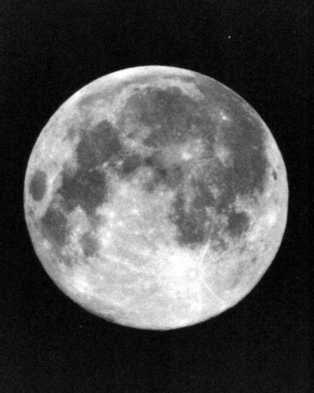
Subject: lunar halo Sent: Monday, February 11, 2002 11:40:08 From: saber@dircon.co.uk (Saber Properties Limited) I just thought I'd send you a recent photo of a massive lunar halo which I captured from my back yard in London UK. Taken with Canon Eos 300 with a 28mm lens. Did not keep exposure settings. Regards, Sam
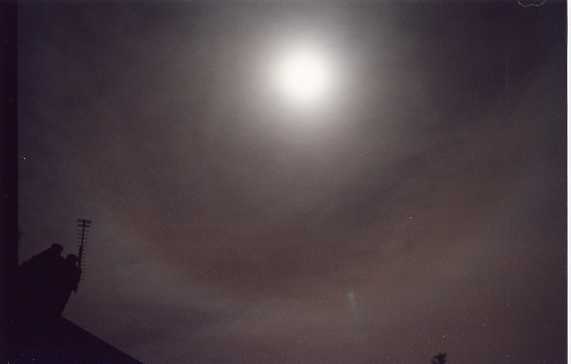
Subject: Jupiter's Close Call with the Moon - Feb.22/02 (9:30 Sent: Monday, February 25, 2002 18:53:08 From: stankiewiczr@cogeco.ca (Rick Stankiewicz) Here is an image of the close call (1/4 degree) that Jupiter had with a nice gibbous moon last Friday. Too bad it does not show the 4 moons that stretched out to the right of Jupiter. It was quite a sight! I was using a Canon F1 @ 1/60 exp. and 400 Konica Centuria print film at prime focus on a Meade ETX. Rick Stankiewicz Peterborough, Ontario Canada stankiewiczr@cogeco.ca
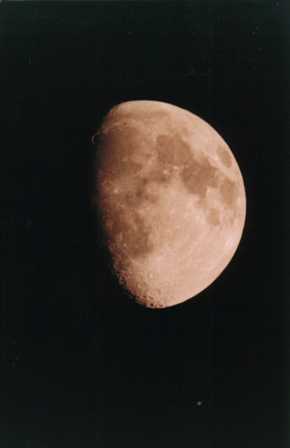
Subject: New ETX90-EC user Sent: Sunday, April 21, 2002 14:46:43 From: karrowood@coxnc.rr.com (Kyle B. Arrowood) My husband bought me an ETX 90-EC for Christmas and I've used it several times with great views. I'm also a photographer and have attached my cameras (Canon EOS Elan and D30) to the telescope via the appropriate T-ring. I've taken many pictures however they are all slightly blurry. This seems to be due to incomplete "tightening" or slipping of the telescope when the camera is attached. Any suggestions?? Thanks, KyleMike here: Focus SLR cameras can be a challenge. If your camera has interchangeable viewscreens, switching to a clear one can help. If the blurring is due to vibrations from the mirror/shutter movement then all you can do is the "hat trick" technique. Cover the telescope aperture with a dark object but don't touch the telescope with it. All you want to do is block light from entering the telescope. Open the camera shutter and keep it open (using the Bulb setting). Let any vibrations dampen out. Flip the cover away from the telescope aperture for the duration of the exposure. Recover the aperture and release the shutter. With practice you can get short exposures and of course, this technique works great for longer exposures.
Subject: T adapter for ETX 90 Sent: Monday, October 21, 2002 15:29:25 From: monopertuz@yahoo.com (Fernando Pertuz) My old 35mm pentax has chosen to pass to a better life. I just bought a Cannon EOS and I would like to buy the appropriate T adapter, but I am hesitant to order it via the web not knowing what to ask for (i.e. part number). There are no meade dealers here in Colombia The Mead website only says here are diferent one for diferent cameras but will not provide an e-mail for qweries (they stil rely on the good ol' US Postal Service and prvide a mailing address. How can I know what to order, pls help. Thanks Fernando PertuzMike here: There are two components that you need (see the Accessory Reviews - Astrophotography). One is the camera-specific T-Ring. The other is the Meade adapter. You can contact the online dealer and tell them what type of camera you have (it needs to have a removable lens). They will supply the T-Ring for that camera.
Return to the top of this page.
Go back to the Astrophotography Page.
Go back to my ETX Home Page.